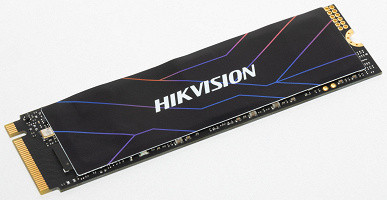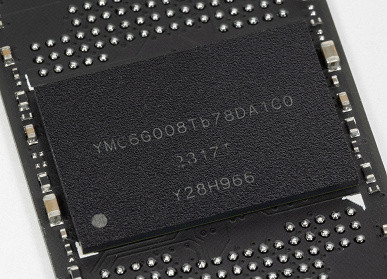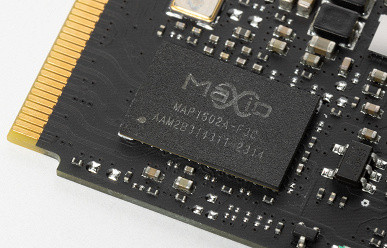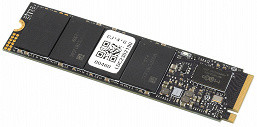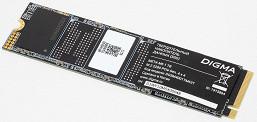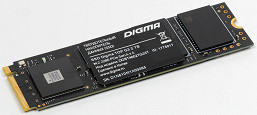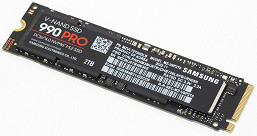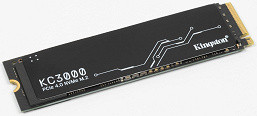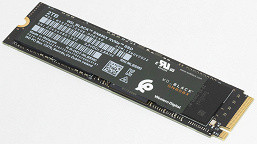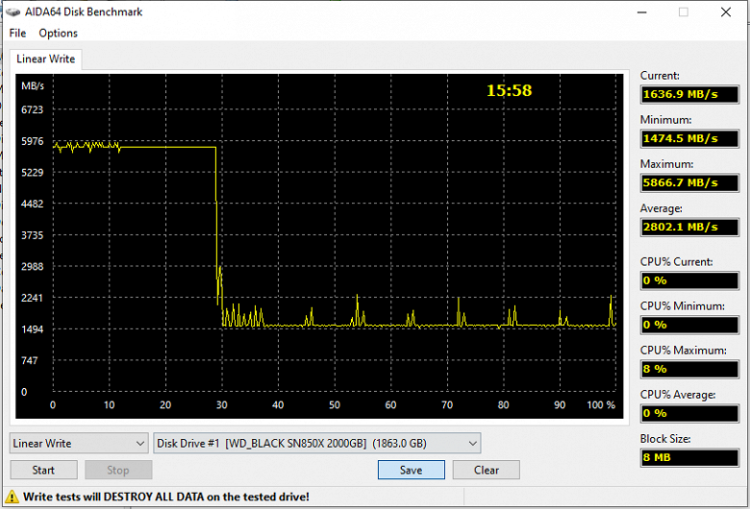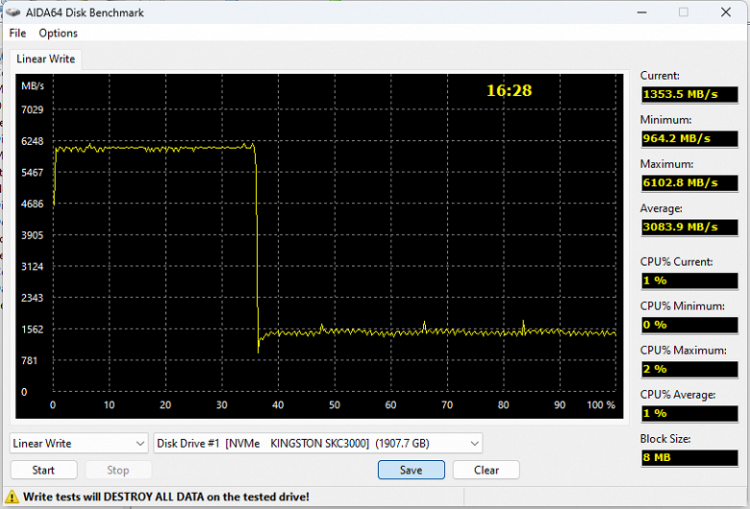We have already devoted four articles to the Maxiotek MAP1602 controller, examining three different configurations. This may seem like a lot of attention for a budget product. However, we have reasons: firstly, this is a very interesting solution for its segment, and secondly, it was budget models that mainly stimulated the growth of the solid-state drive market in recent years. That's why we devoted a lot of material to budget controllers in general. The Phison E13T was reviewed in five articles, the similar Silicon Motion SM2263XT received the same amount of attention, and cheap SATA drives were discussed more than once. The only difference is that these materials were released at intervals, whereas with MAP1602 we decided to quickly dot the t's. This is justified by the presence of at least two significantly different modifications of these drives. In older budget models, the spread in memory speed was smaller, since the differences were more often leveled out by controllers. Today's article will be the last part of the review, although it is possible that we will return to this topic. Reduced shipments of YMTC's 128-layer TLC flash and sanctions imposed on YMTC have forced manufacturers to experiment with the MAP1602 controller and memory from other vendors, such as Micron's B47R 176-layer TLC flash. If possible, we will definitely study how it works. But for now let's focus on the “quick” modification.
What gaps remain? We've already explored how this controller works with YMTC's latest 232-layer TLC memory. It turned out that this is indeed a very fast combination for its segment. However, we tested a terabyte drive, which was not enough. The new memory is produced in 1 Tbit crystals, which for terabyte drives means double interleaving instead of the previous four times. To compensate for this effect, all manufacturers use internal interleaving, which leads to the appearance of various modifications of similar memory. For example, WD and Kioxia have 112-layer BiCS5 with 512 Gbit crystals, which can be either slow (2-plane) or fast (4-plane). There is also a very slow version — 2-plane on terabit crystals. All this is BiCS5, but with different characteristics, used in different products. Therefore, increasing the capacity of the crystals used to proportionally reduce the speed, but this is no longer the case. For YMTC, 128 layers are 4-plane 512 Gbit, and 232 layers are 6-plane 1 Tbit. Taking into account the external interleaving on four MAP1602 channels, the result is a transition from 16x to 12x — less, but not half. Therefore, in the terabyte version, the new MAP1602 platform is almost always faster than the old one. This means that in a two-terabyte SSD it can show even better results. This is what we will evaluate!
HikVision G4000 2 TB
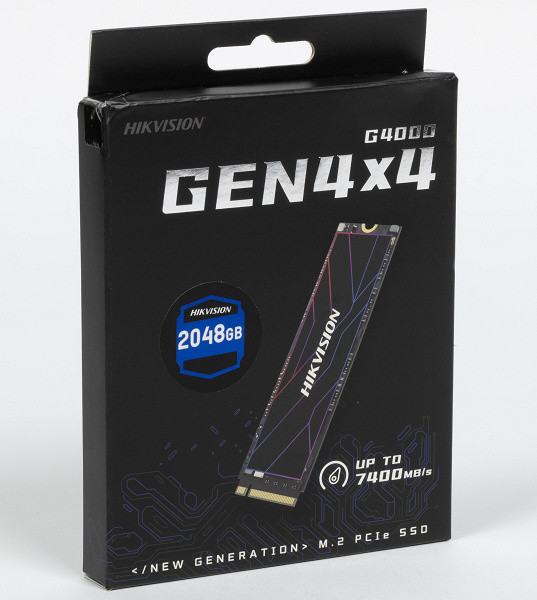
This time we decided not to take risks and not play radical Chinese roulette, given that lately we have been lucky too often, and there were expectations of a catch. However, today's SSD is also completely Chinese. Just four years ago, when we just started working with the products of this manufacturer, the brand in the storage drive market was perceived almost as a no-name. HikVision, well known for its video surveillance systems, seemed to many to be a company that simply stuck its labels on other people's products. But everything turned out to be more interesting. Video surveillance requires a lot of fast storage, so it was easier for the company to tackle this issue itself by creating a subsidiary, HikStorage. HikStorage quickly reached such volumes of work that it acquired independent significance and has long been producing many SSDs for other brands, not just Chinese ones. But, of course, the native brand is always a priority.
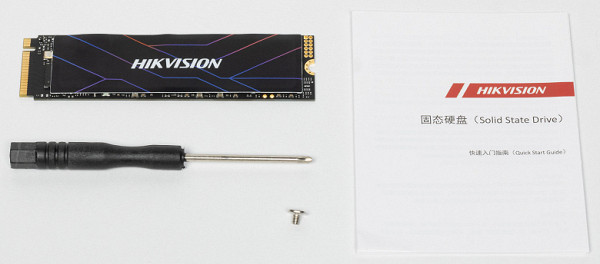
Some mainland traditions are carefully preserved — for example, in the kit you can find a fastening screw and a screwdriver. Strictly speaking, they are not necessary, since motherboard manufacturers have long switched to screwless SSD mounting in M.2 slots. However, such care for the buyer looks very touching.
The SSD itself is covered with stickers by default. The covering of the front side is metallized — so, to the best of its ability, it also works as a heat spreader. But there’s still nothing here from the rear.
Under the sticker on the working side of the device we won’t find anything unexpected: a MAP1602 controller and several memory chips. The configuration is similar to the terabyte version, only each chip now has not four, but eight memory crystals. 128-layer memory is typically packaged less densely, so terabyte drives require four chips. In the G4000 and similar models, the “full set” is used only in 4 TB versions, which has now become possible for budget platforms, and in a single-sided design. However, the older modification can hardly be called cheap, since it often costs the same as the SSD on higher-end controllers. However, there is potential for a price reduction, since manufacturers do not yet see the point in reducing the price. The speeds of 7 GB/s achieved by this platform when reading data were until recently characteristic only of top-end controllers. Moreover, some manufacturers have already released 8TB single-sided SSD boards. In this segment, prices for devices depend nonlinearly on capacity, but it is important that such drives appear on sale at all, albeit in limited quantities. More recently, 4 TB versions were found only in double-sided versions.
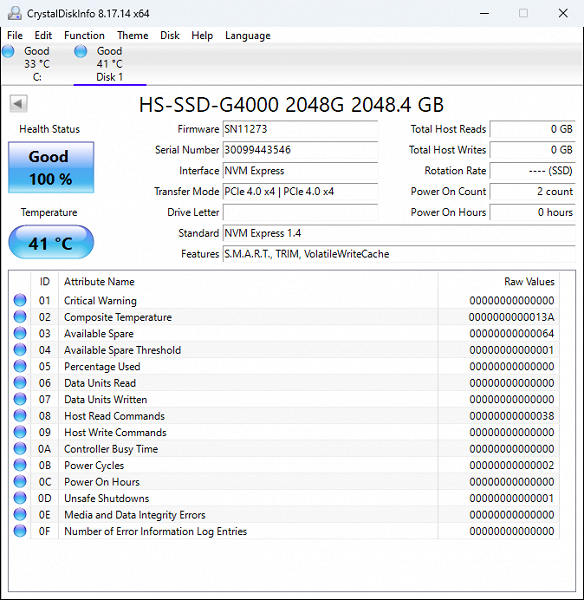
In conclusion, we strongly recommend not to confuse the HikVision G4000 with the more affordable G4000E. We have already mentioned the main difference between them several times: the G4000E is an economical version with 128-layer memory. All results obtained previously for similar configurations are applicable to it. While the 2TB G4000 should demonstrate new capabilities without a DRAM buffer. But, of course, this may or may not happen — it all depends on the specific circumstances. However, we believe in its potential, because there is good reason to do so. It's important to note that savings may not always be possible when purchasing the G4000E, especially during periods of significant fluctuations in flash memory prices — in some cases, these SSDs can cost almost the same. In such a situation, of course, a more advanced model is of greater interest.
Testing
Samples for comparison
As for direct comparison, we need a Fanxiang S660 SSD with a capacity of 2 TB on the same controller, but with a slower 128-layer YMTC memory, and a Digma Meta M6 with 232-layer memory, but with a capacity of only 1 TB. Ultimately, specific models are not so important — the platform itself is important here, since manufacturers do not often rework it deeply, limiting themselves to reference designs. Moreover, many companies that work with Maxio controllers may change the controller itself without notice. For example, Netac first released its NV7000 model on Phison E18, then switched to InnoGrit IG5236, and then the NV7000-t appeared — already on MAP1602. Many small manufacturers have also carried out such assortment updates since the end of last year. Although formally this is not always good, if we look at it from the point of view of details, for example, abandoning an eight-channel controller with DRAM in favor of a four-channel one without. However, no one promised anything concrete in such cases. And since the “upgrade” from IG5236 to MAP1602 turned out to be quite common, we decided to directly compare the results of these two platforms — for this we will need Digma Top G3.
Since we touched on the top segment, it’s worth continuing and deepening this topic. The next three are focused on the Kingston KC3000, Samsung 990 Pro (which is, in fact, the fastest PCIe Gen4 SSD) and WD Black SN850X. Although the results of comparison with such models are predictable, they are still interesting. It's clear that budget four-channel platforms don't compete directly with today's top-end models. But this is not their goal — after all, they are still much cheaper. However, the question of how much they lag behind (and whether they always lag) remains open.
Filling with data

MAP1602 and 128-layer YMTC flash memory are found in an affordable SSD on AliExpress. But if you ignore these details and go back a few years, no one will notice the catch. Cache write speeds are up to 4 GB/s, direct writes reach 1.5 GB/s, even speeds under heavy loads exceed 500 MB/s — there was a time when even top-end SSDs showed worse results.

With the new memory, terabyte SSDs can achieve the same results. However, they will remain at the same level, and will not improve, as described at the beginning — due to a decrease in the interleaving factor, despite the increase in the speed of the memory itself. On the other hand, the write speed to the SLC cache increased, but other indicators remained at the same level. Therefore, buyers have nothing to complain about.
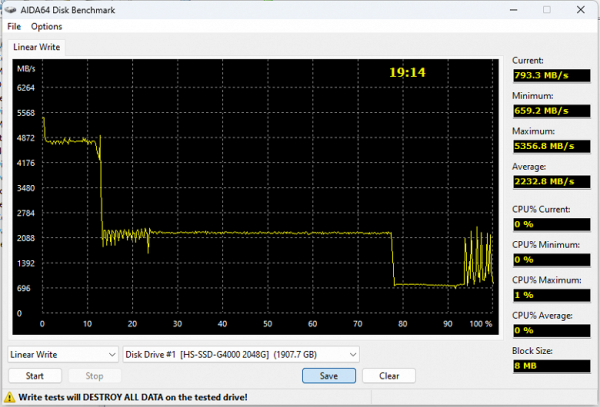
Moreover, in this scenario, switching to a “full” (in terms of interleaving) configuration does not bring significant changes. The maximum write speed remains slightly higher for a terabyte SSD, but the speedup of both direct writing to the main array and clearing the cache at the end is noticeable for most users. The reasons for this are not secret — modern SSDs of this level already provide excessive speed for most application programs. With the exception of benchmarks, but usually only cache and tested in everyday conditions.
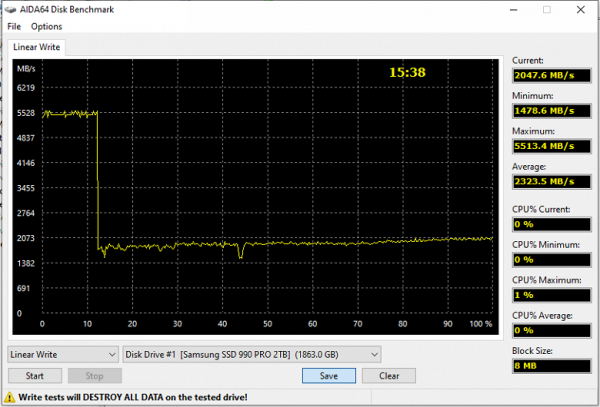
Even when compared with the Samsung 990 Pro, the new platform is not much inferior. Although, of course, the Samsung 990 Pro has higher speed. However, the main thing here is that the powerful controller is capable of transparently clearing the SLC cache without speed penalties. While MAP1602, being a cheaper and simpler solution, cannot do this. But this is typical not only of the MAP1602, but also of other budget controllers, and sometimes even top-end controllers of the PCIe Gen3 era.
The SLC caching settings of the Kingston KC3000 and WD Black SN850X differ significantly from previous models, which has an impact on results comparable to the characteristics of the hardware. In practice, this approach may or may not be beneficial — it all depends on the specific use cases.

One thing is certain — the InnoGrit IG5236 is a thing of the past. In 2020, it attracted attention not only for its performance, but also for its affordable price. The developer sold these eight-channel controllers with support for PCIe Gen4 (which had not yet become a standard) at a price slightly higher than budget products, providing performance comparable to the top models of the time. But new controllers in this class already deliver high speeds, and more affordable options like the MAP1602 can offer comparable performance at a lower price. This was the reason for the massive transition of SSDs from IG5236 to MAP1602. Formally, this may be perceived as a downgrade, but in practice it may be different.
Maximum speed characteristics
Low-level benchmarks, including CrystalDiskMark 8.0.1, have long been victims of an unequal battle with SLC caching. They can only test the cache without detecting anything outside of it. However, the information provided by manufacturers about device speeds is also limited by the cache. Therefore, checking these devices is always useful. All the work on caching is aimed at making sure that the cache is used as often as possible in real life and demonstrate high speeds, despite the reduction in memory costs.
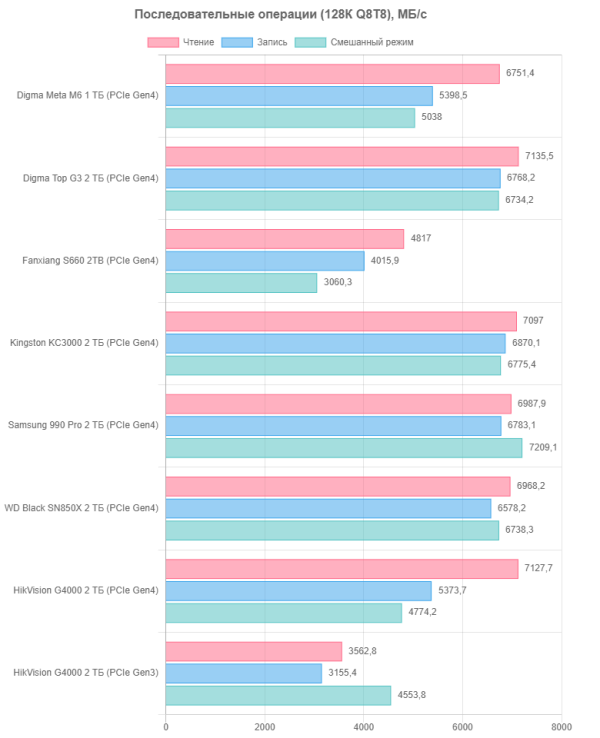
Capacity does not play a role here precisely because the utility, in principle, does not go beyond the cache. Therefore, there is no new information — modern budget controllers, with fast memory, can already run into the limitations of Gen4, which not so long ago required eight-channel solutions. At least this is possible with “pure” reading or writing — the mixed mode (albeit simple in the case of this program) still immediately shows who is who. As a result, the outdated IG5236 looks more interesting. But we will refrain from drawing conclusions until more serious loads are used — CrystalDiskMark, as has been said more than once, we use only because of its popularity. But the practical benefits of parrots from this particular program are less and less. Therefore, it can only complement other benchmarks, but nothing more.
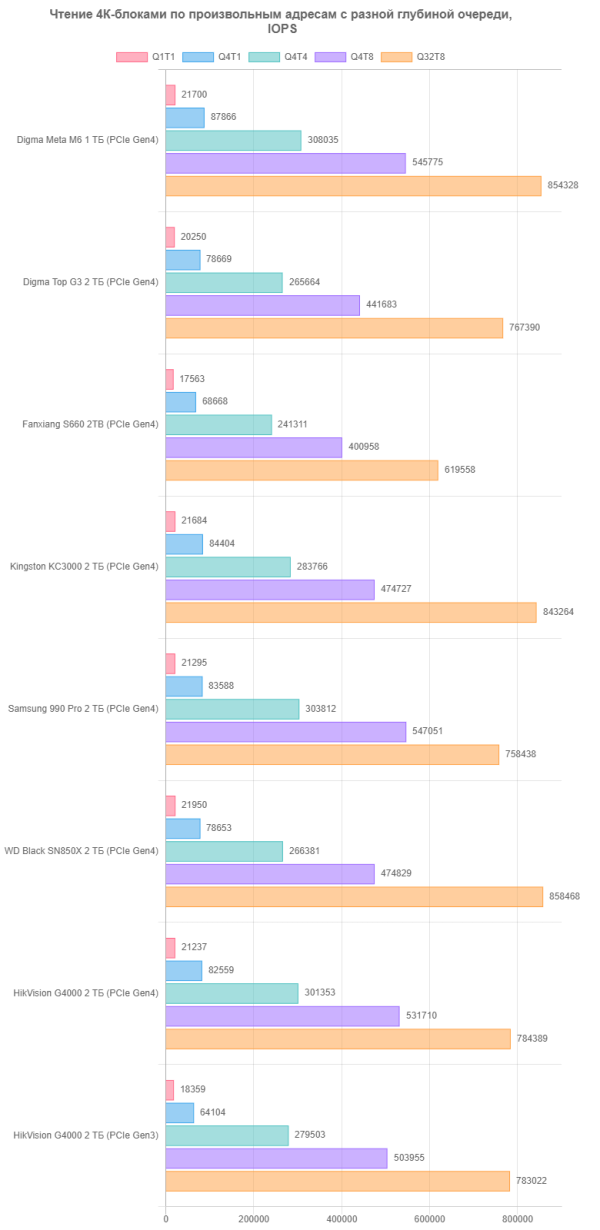
For models of different capacities here (and further) the above remark is true. As for the rest, what we already know: this platform at least packs as many CDM parrots as it does tops.
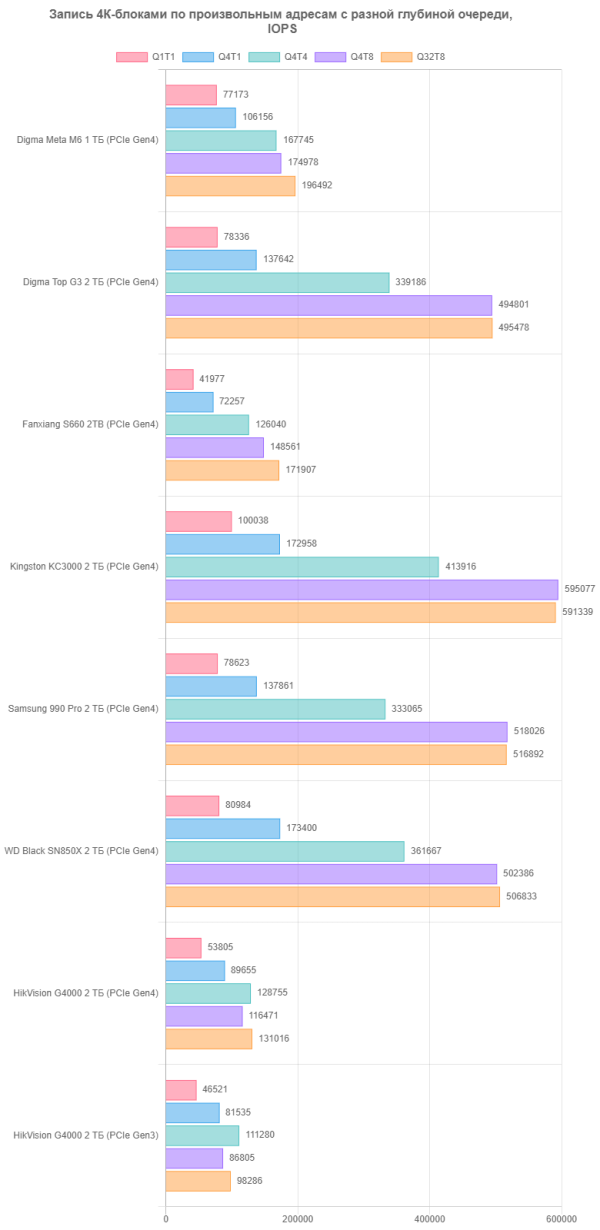
Once again, the increase in capacity does not benefit recording, and the lag behind more high-end platforms remains noticeable, although it is inferior to the already outdated ones. In practice this is of little significance since sequential speeds are rarely required in modern software.
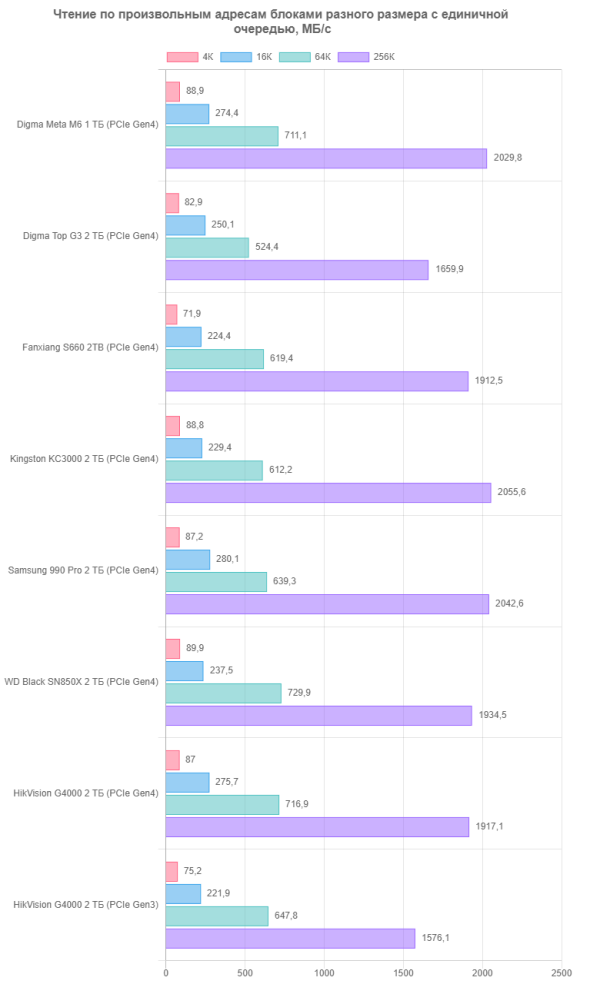
The impact on the speed of real software is more significant than the previous factors: long queues of operations are practically never encountered, but data blocks other than 4K bytes are common. Although the number of operations per second on large blocks may be slightly lower, such blocks are usually larger in size, which increases the resulting speed in megabytes per second. Therefore, most programs prefer to work with such blocks. However, all modern SSDs are already much faster than programs require, and this discipline is gradually losing its meaning. Today's top-end SSD models are at their best in this race, but some modern budget platforms are just as good in this regard.

Nothing revolutionary happened during the recording. Even the top-end HikVision is inferior in speed to the inexpensive Digma with a smaller capacity — too much lately depends on the firmware settings. This is especially noticeable when it comes to the results of low-level utilities, which often turn out to be unattainable in practice.
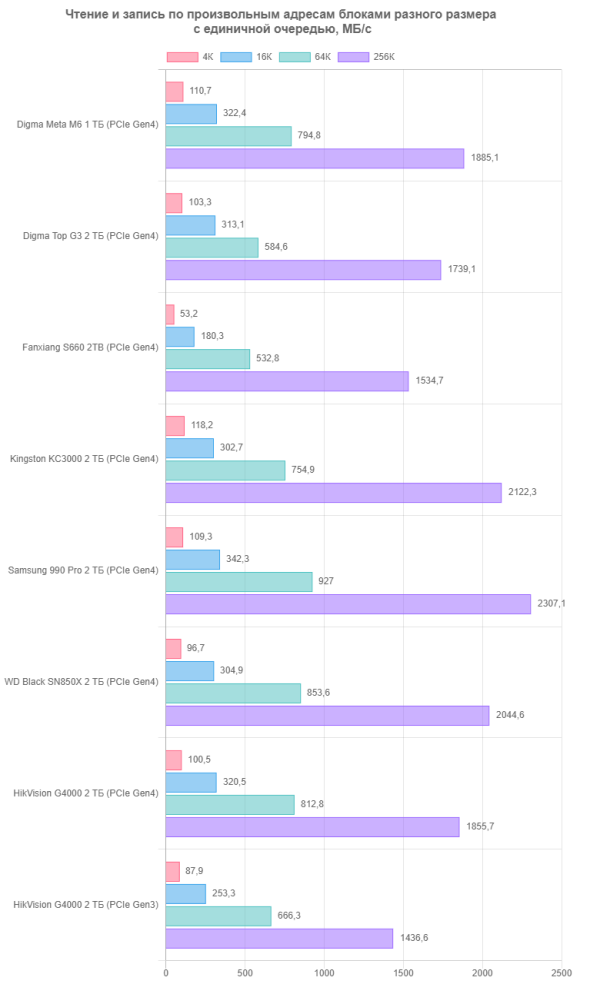
Mixed mode operation is also important because in reality it is rarely the case that data is either write-only or read-only. This is especially true in a multitasking environment and when there are a variety of operations on operating systems. But there is nothing new or unexpected here — it is all predictable. The main conclusion is that choosing an SSD based on the results of low-level tests today is risky, because such tests only demonstrate the potential capabilities of controllers under ideal conditions, which are rarely encountered in real life. We always hit the cache, so writing always occurs in a fast one-bit mode, and reading from the SLC cache is faster than from the main memory array on all modern (and not only) platforms. Therefore, it is time to look for other tools to measure these characteristics.
Working with large files
Although results in low-level tests can be impressive, achieving such speeds in practice is not always possible. This is because working with larger files is always more complex. For example, CrystalDiskMark operates on small pieces of information within a single file. In real life, files are typically located in the SLC cache and are subject to file system overhead operations such as MFT modification and journaling. Therefore, recording does not occur sequentially in one place, but in different places, partially in small blocks. For more accurate testing, including working with the cache and a loaded device, the Intel NAS Performance Toolkit is used. This tool allows you to run tests not only on an empty device with the maximum cache size, but also in more realistic conditions when there is almost no free space.

Working in one thread is the most common scenario (146% of cases), but it is also one of the most difficult. For modern controllers, however, this is no longer so difficult. The speed in this scenario primarily depends on the generation of the platform, and then on other small nuances. Even top platforms have barely reached 4 GB/s, while budget platforms, even the most ambitious ones, do not yet need PCIe Gen4 support. This is important to remember when looking at peak numbers in low-level benchmarks, and to take into account the operation of SLC caching even when reading data. This has already led to different results for the terabyte and the two-terabyte: the second is capable of producing 3.4 GB/s even from the main memory array, while the first lacks double external interleaving for this.
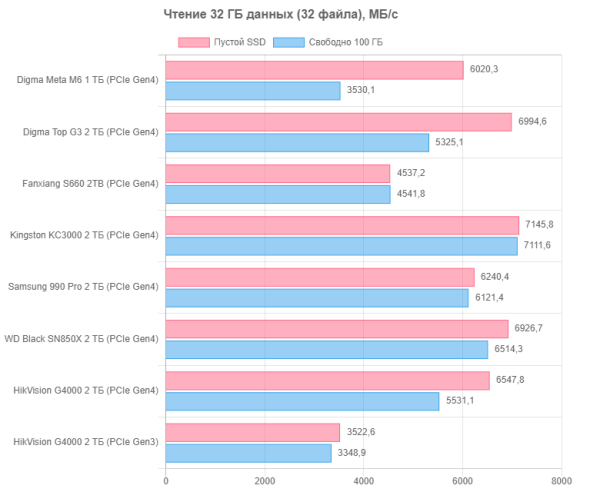
Multi-threaded mode allows you to see what SSDs are capable of, but in such conditions it quickly runs into interface limitations. Even when we read data from the SLC cache, even a two-terabyte SSD does not have enough native resources to reach at least 6 GB/s beyond its limits. Interestingly, the models on IG5236 show the same, even with some degradation. Thus, the new Maxio platform can reach the level of top-end SSDs, but does not necessarily remain at this level. While SSDs with a capacity of two terabytes have a more stable result, the new terabyte models may even lag behind their predecessors in complex scenarios. However, manufacturers often do not demonstrate such scenarios, focusing on peak performance.
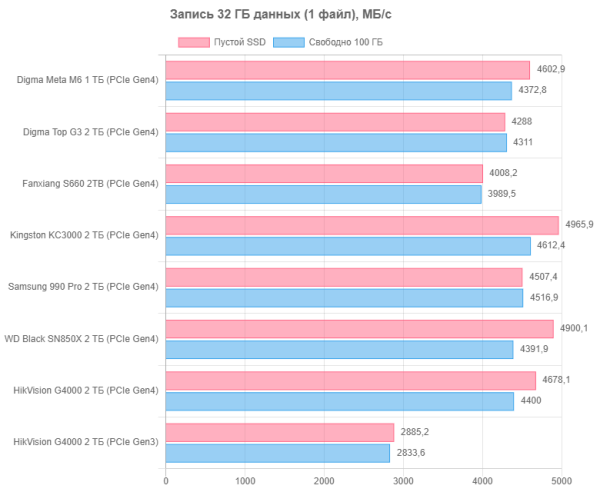
With recording, things are funnier. Firstly, not a single SSD, even a top-end one, can do without caching. Secondly, the bottleneck here may not be the hardware, but the WinAPI functions for working with files. This happens for a simple reason: ten years ago, speeds of gigabytes per second were unimaginable, and there is a lot of code left in the programming interface that was created back in the last century. This, of course, primarily plays into the hands of budget platforms, including low-capacity SSDs. The main requirement is that there is always enough free space in the SLC cache.
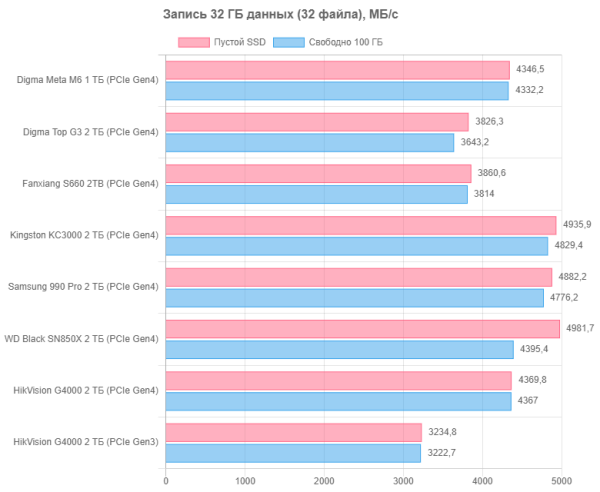
The algorithms for working “inside” the drive become the same as in the previous case, so the problems are the same and the achievements are the same.
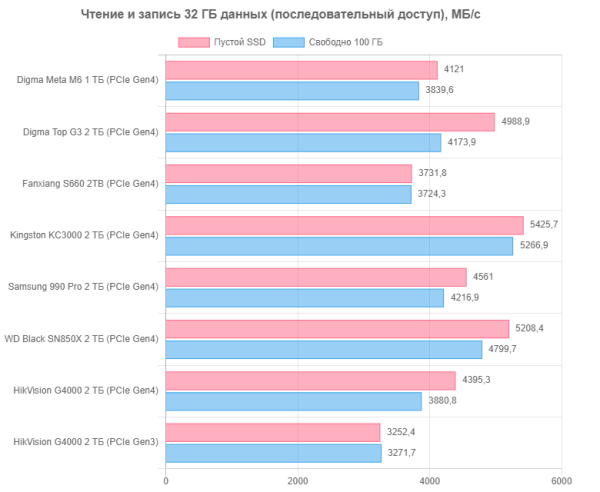
In CrystalDiskMark, it was seen that bidirectional operations instantly differentiate four-channel bufferless budget controllers from eight-channel top-end controllers, even if they are not the latest. Increasing the capacity and, consequently, the frequency of alternation has a beneficial effect on the results, but it is still far from overcoming the stated limit. In practical terms, this is not critical, for example, when unpacking large archives, where performance is limited by other computer components. However, the fact itself is interesting. Increasing the sequential speeds of «pure» operations will not necessarily speed up the mixture. Ultimately, this is what manufacturers of high-end devices charge money for — the ability to cope with real-world loads, and not just ideal conditions.
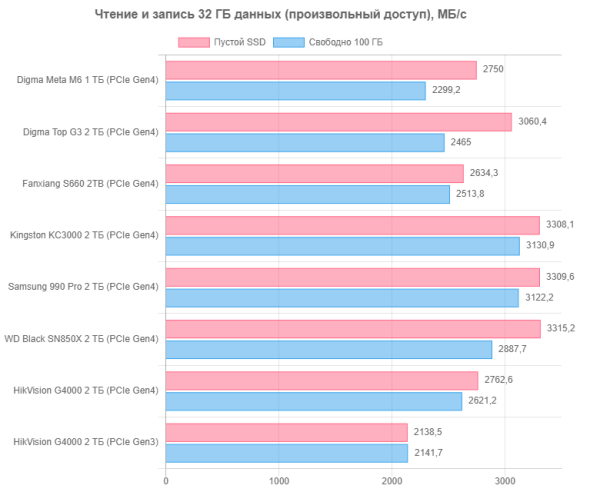
Indeed, this type of load is typical for the operation of the system drive of any computer. The only difference is the amount of data transferred, which is not limited to 32 GB, but pauses in work can be long and require more time than active work. As a result, this is a mixed type of load in which it is not so easy to erase the boundary between segments. Test scenarios with a limited amount of work do not require accelerated work with the address translator using DRAM caching, which plays into the hands of budget controllers, but also provides room for improvement in high-end devices.
Although it takes effort to reach the level of the best models based on InnoGrit IG5236, it is possible, and therefore manufacturers are actively pursuing such replacements. Today's top models are undoubtedly faster, but the MAP1602 platform with its large amounts of modern memory is also very fast. The smaller memory capacity of terabyte models limits their performance, but previous versions, although slower due to memory characteristics, are still competitive.
Comprehensive performance
Currently, PCMark 10 Storage is considered the best comprehensive benchmark for assessing storage performance. The tests included represent a variety of use cases ranging from operating system loading to data copying, making it a useful tool for evaluating performance under a variety of conditions. Of all the tests, preference is given to the full Full System Drive test, which covers almost all typical use cases.
The remaining tests are included only as part of this complete set and, in our opinion, are not that interesting. However, this particular test is useful for accurately measuring the actual performance and lag experienced by various tasks. While averaging metrics may be a bit synthetic, it still provides a more realistic estimate of overall performance. Thus, familiarizing yourself with PCMark 10 Storage is an important step to understanding the capabilities and characteristics of drives.

This test highlights the importance of using SLC cache not only to speed up write operations, but also read data. We've seen Maxio MAP1602 or InnoGrit IG5236 platforms make heavy use of SLC cache to deliver high peak results. However, if the cache capacity is not enough to store the entire amount of test data, performance will drop dramatically. This problem also affects the Kingston KC3000 SSD, which chose a caching scheme unusual for the Phison E18 controller, aimed at increasing peak performance. As a result, performance drops sharply, especially when there is insufficient free cache space.
To improve consistency of results, it is recommended not to fill the device to the top. We have set a minimum limit of 100 GB of free space for 500-1000 GB devices, although this may be too low for some SSDs. It is usually recommended to leave at least 10% of the capacity free, and ideally 15%-20%. This is necessary for the normal functioning of file systems and SLC caching. Based on these principles, our tested platform stands out, joining the ranks of top solutions and even ahead of some of them. Overall, this is an excellent result for a budget bufferless controller.
Total
«Erasing boundaries»: choosing between SSD drives
While the title may seem provocative, completely “blurring the lines” between different types of SSDs is always a controversial issue. The difference between eight-channel multi-core controllers with DRAM and simplified four-channel solutions remains a fact that cannot be ignored. While quad-lane models can utilize the full bandwidth of PCIe Gen4x4 in simple scenarios, speeds remain variable in demanding environments.
However, this may only be important for those who are looking to purchase a top-end SSD. In most cases, this decision may turn out to be somewhat irrational, given that even a good SATA SSD usually does not become a bottleneck in the computer. The potential capabilities of modern top-end SSDs are rarely used to their fullest, but at the same time they come at a high price. Everyone decides for themselves what to spend their money on, but most users need a reasonable compromise.
In this sense, the latest modification of the Maxiotek platform offers an excellent option. It outperforms its predecessors and competitors by offering a good balance of performance and price. New SSDs based on this platform will look even more attractive compared to their analogues, especially at comparable prices. The ability to pack up to 4 TB or even 8 TB into a single-sided drive, although expensive, can be a deciding factor in some situations.
Based on several tests, it is clear that terabyte drives are sufficient for most users. However, the Maxiotek platform is at its best with capacities starting from 2 TB, making it an attractive option for many applications.

